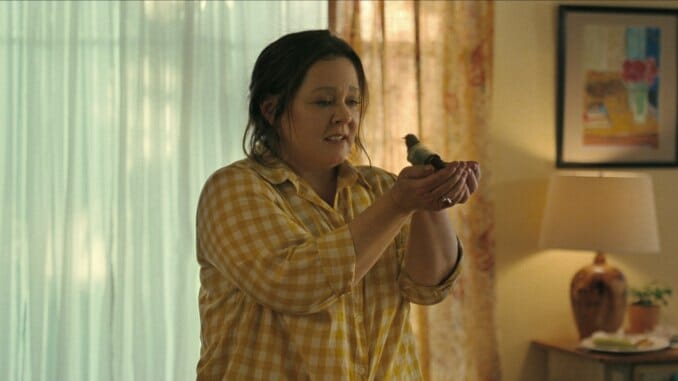Birdbrained Dramedy The Starling Bypasses Reality for a Featherlight Point

The Starling had me worried as soon as it opened with a CGI bird doing a fly-by of the core characters in the film—all yet to be introduced and definitely existing nowhere near one another considering the flight terrain—serving like some sly master of ceremonies for what’s to come. It’s important to note this starling is not presented as a trained homing pigeon, sentient, nor does it have some magical, tiny bird GPS pins guiding its route. It’s just a bird in the wild flying by “happenstance,” which is one of many cloying recurring themes in The Starling that pop up as subtly as that goose that smashed Fabio’s face on a rollercoaster years ago. Seeing that CGI starling raised my hackles, warning me that if a film is so confident at telling me it’s going to willfully manipulate whatever it wants, including “wild” birds, to serve the purposes of whatever illogical and ill-thought-out idea it wants to run with, then I’m in trouble. And it turns out my bird-dar was right.
At the center of the story is the marriage of Lilly and Jack Maynard (Melissa McCarthy and Chris O’Dowd), a grocery store manager and grade school art teacher, respectively. A year before the movie begins, they are happily married and well-matched in wit and disposition. A little girl is on the way and they’re working on the home left to them by Lilly’s grandfather. But then their baby Katie dies of SIDS and Jack has a breakdown that puts him in a mental treatment facility an hour away. His choice to be an in-house patient leaves Lilly miserable, alone and with the obsessive arrangement of Hostess Snowball displays as the highlight of her days.
While Jack seems to be stuck in therapy with no movement, positive or negative, Lilly is left doing the long weekly drive, bottling up her own pain so she can be there for Jack in case he’s ready to share anything with her outside of simmering anger. Observing Lilly also suffering, a facility therapist weirdly recommends that maybe she see an old colleague, Dr. Larry Fine (Kevin Kline), who is now a practicing vet. And that’s where the CGI birds come back, as Lilly is attacked by one in her front yard as she’s trying to do lawn work. Pecking her in the head, that wily little bird becomes the bane of Lilly’s existence and she keeps seeking Dr. Fine’s advice about how to thwart it—but we all know that she’s really asking him how to overcome her own depression, anger and grief.
While McCarthy and Kline’s scenes are the only ones that feel truthful in the movie because of their natural chemistry and self-modulation tempering the maudlin, the rest of the movie has no such luck. The tone veers wildly from scene to scene. Like, for some reason, Jack’s group therapy peers are treated like “wacky crazy people” who make dirty needlepoint light switch covers for laughs, or erupt like extras from a Jerry Springer audience during visitor group therapy days. And it’s just “funny” to see O’Dowd crack wise as Jack avoids dealing with his issues and becomes increasingly hostile at Lilly trying to move forward. If we’re supposed to like or sympathize with Jack, the movie does its best to not have that happen.
-

-

-

-

-

-

-

-

-

-

-

-

-

-

-

-

-

-

-

-

-

-

-

-

-

-

-

-

-

-

-

-

-

-

-

-

-

-

-

-








































